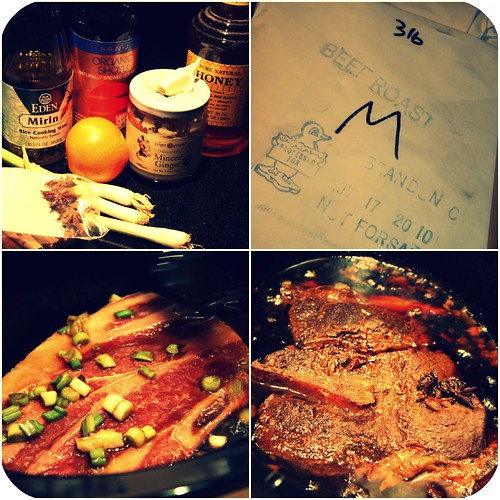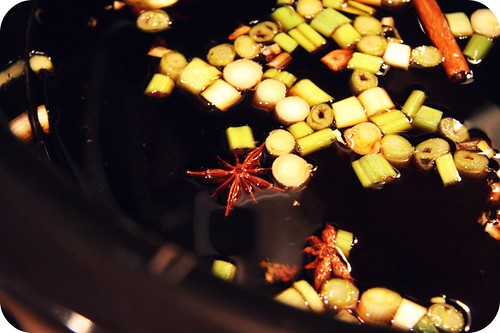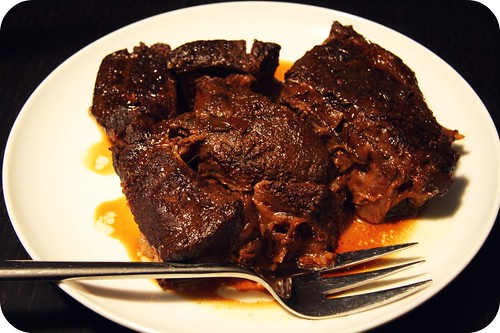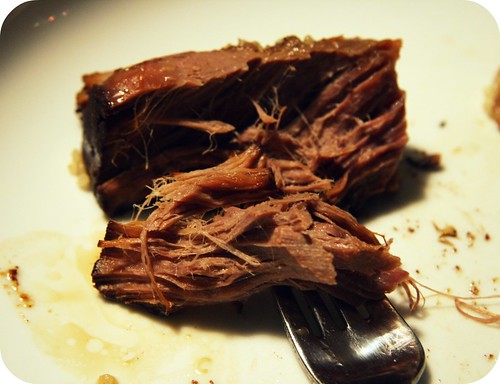Happy 100th post! I love food! (And so can you!)
I can't wait to see what kind of google search terms lead to this post. "Slow and red" seems like it could be open to a great deal of interpretation. And "rump" just makes me laugh a little. In this case, "slow" refers to the use of your trusty slow cooker, and "red" refers to a Chinese method of poaching or braising meat in a salty-sweet liquid with a bunch of delicious spices, the combination of which makes a beautiful flavorful reusable sauce. "Rump" refers to the particular cut of meat that I used when I made this meal: a big, juicy cut from "the fleshy hindquarters" of the animal.
This recipe is fantastic and easy. It involves using up most of that bottle of soy sauce in your pantry and it may require a trip to the grocery store if you don't happen to have star anise already in your spice drawer. (But you'll probably want to go to the store to get the freshest, best-looking rump roast you can find anyway.)
Whole star anise is featured in the picture above, the delicate, flower-shaped item. Pretty, eh? I have never had a problem finding it in the regular spice section of a regular grocery store, but if you can't find it there, they sell it in bulk at co-ops (which means it will cost you like 10 cents if you just buy the two you need), and the cookbook from whence this recipe arrived suggests trying the Asian or Latin American foods sections of large grocery stores, or an Asian or Latin American market.
This recipe does everything to a big, juicy cut of meat that you want your slow cooker to do, AND THEN SOME. At first, when you see all the marbling (in addition to the 1" thick coating of fat) that a big, juicy rump roast has to offer, you're a little stunned and afraid. Will this give me a heart attack? you might wonder. (Probably not, but you can do your own research on that.) After slow-cooking the roast, however, the marbling produces the juiciest, tenderest roast you've ever tasted, and the thick coating can be scraped off easily with a fork (and given to your toddler, who needs it and loves it).
This is the kind of slow-cooked roast that literally melts in your mouth.
I miss it so much.
Also: I wasn't kidding about reusable. At the end of the recipe there are instructions for how to strain, store, replenish, and reuse the sauce as many times as you'd like/feel comfortable doing.
Slow-and-Red-Cooked Rump Roast
Adapted only ever-so-slightly from Not Your Mother's Slow Cooker Cookbook (which doesn't have any pictures and might be a good cookbook to buy for your Kindle - something I'm aching to do but keep running into road blocks)
Yield: 6 servings
1 1/2 cups water
1 cup soy sauce
1/4 cup mirin (or any kind of rice wine or dry sherry or rice vinegar)
2 tablespoons honey (or sugar or something else sweet)
2 green onions, white and green parts, roughly chopped
1 tablespoon minced fresh ginger
2 cloves garlic, minced or pressed
2 whole star anises
1 stick cinnamon
1 strip orange zest, about 3" long
3-4 pound rump roast, blotted dry
Pour all the ingredients (except for the roast) into the slow cooker. Whisk together a bit, cover, and cook on HIGH for 30 minutes to an hour.
Put the roast in the slow cooker and carefully turn to coat both sides with liquid (you could just spoon or baste the liquid over the top and sides). Cover, turn the heat to LOW, and cook for 4 hours. Carefully turn over the roast, cover, and continue to cook on LOW for 3-4 hours more.
When ready to eat, remove the roast from the cooking liquid and place on a cutting board or serving plate. Allow to rest for about 10 minutes, then either carve into thin slices or shred with two forks. Drizzle with a few spoonfuls of the cooking liquid and serve. (Good with plain rice or alongside a Sweet Potato-Quinoa salad.)
To reserve and reuse the cooking liquid: Allow the remaining cooking liquid to cool a bit and then pour it through a strainer into a heavy glass jar (we use a Mason jar). Discard solids. Allow to cool completely, cover the jar, and refrigerate for 7-10 days, or freeze for up to 3 months. To reuse the red-cooking liquid, thaw if frozen, remove and discard the fat that has solidified on top, and pour the liquid into the slow cooker pot, proceeding with above recipe with fresh meat, OR making roast chicken (see below). So far the most we've used it is two times after the initial braising. We've never stored it in the freezer. I'm sure more than two times would be fine and freezing would be fine, but we don't eat meat that often and our freezer is tiny. The original recipe suggests that after every third or fourth use, you can "refresh the liquid by adding 1/2 cup soy sauce and half the seasonings". (To me, starting over seems just as well.)
To make roast chicken: You'll need a 3-4 pound whole chicken (broiler/fryer), giblets discarded. Rinse and dry the chicken well. Either stir all the ingredients together if you are starting from scratch, or pour the stored cooking liquid into the slow cooker. (You'll want about 3 cups of fluid, so add a little soy sauce and/or a little water to make up for any deficit.) Add the chicken to the red-cooking liquid in the slow cooker and turn it to coat. Leave it breast side up, cover, and cook on HIGH for 1 hour. Carefully (seriously - this is harder than is sounds like it should be, use both hands, one with large tongs and the other with a large fork inserted in the cavity) turn the chicken over, breast side down. Cover and cook on HIGH for 1-2 hours more, until an instant-read thermometer inserted into the thickest part of the thigh registers 180 degrees. Remove chicken from cooker. Either allow the chicken to cool for 10 minutes and then carve to serve immediately, drizzled with some sauce; or, to serve it cold (what we do), refrigerate the chicken, uncovered, before cutting or shredding it as you'd like. Follow above instructions to reserve sauce again.





Sounds tasty, I might have to make this before crockpot season is over! I bet this roast would make good pulled sandwich too, if you did an asian slaw and served it on a bun... Yum!
ReplyDeleteYou really should use the sauce more times to experience how great it really can get. In china they reuse the same sauce indefinitely. If this concept worries you, it shouldn't, as long as you cook with it on a regular basis you are effectively pasteurizing the cooking liquid every time. With each use the sauce becomes richer and more complex.
ReplyDelete